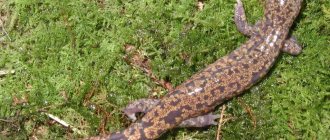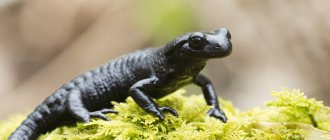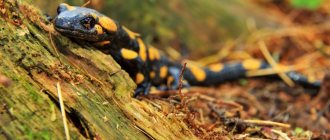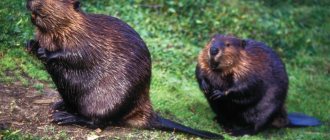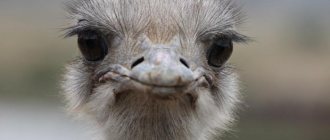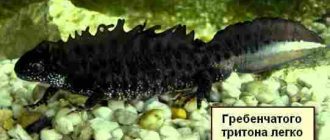Just two centuries ago, Alpine peasants warned brave naturalists who were going to get to know the small amphibian salamander: “Be careful with this terrible lizard - it is very dangerous! Firstly, it is terribly poisonous, and, secondly, it is very difficult to kill - it does not even burn in a fire, it gets out of the fire without damage...” We will talk about salamander venom below, but as for fire, this is nothing more than one of the ancient myths passed down from generation to generation. In fire, a salamander, of course, burns, like all living beings.
In medieval beliefs, the salamander was the spirit of fire. He was depicted as a burning lizard, which constantly lived in fire and personified its element. Perhaps the color of the amphibian seemed fiery to the people of the Middle Ages, and this real animal was called a salamander. Living salamanders were a permanent “professional” attribute of magicians and sorcerers.
general characteristics
The body of salamanders is elongated, there is a smooth transition to the tail area. The sizes of representatives of this genus are different and can vary from small 5 to a very impressive 180 cm. The largest salamanders are the Chinese giant salamanders.
Animals are smooth to the touch, and their skin is constantly moist. Salamanders have quite a lot of color options: the color scheme depends on the variety and area of residence. Thus, salamanders can have yellow, black, red, purple and other color options. The area of the back and sides is often covered with spots or stripes of different colors and sizes.
Desmognathus wrighti is the smallest salamander on Earth: its size does not exceed 50 mm
The legs of animals are quite short and at the same time strong. There are four toes on the forelimbs and five toes on the hind limbs. Animals have no claws, and the limbs themselves are poorly developed.
The skull of salamanders resembles the head of frogs, especially due to the characteristic bulging eyes. In addition, dark eyes and moving eyelids add similarity. Thanks to this anatomical feature, salamanders can explore nearby areas without having to turn their heads.
Salamanders have poorly developed jaws, which is due to their anatomical features. Thus, animals are not adapted to eating hard food. In addition, representatives of this genus are characterized by clumsiness, due to which they feel much better in the aquatic environment than on land.
Salamanders differ from their close relatives, lizards, by a wide variety of colors, which include almost all the colors of the rainbow. Such bright and spectacular colors often highlight dangerous animals in nature.
In the legends that were written in ancient times, salamanders were assigned the role of servants of dark forces. This belief was due to the unusual appearance, as well as the specific method of defense of salamanders, due to which their enemies get severe skin burns.
Description
Adult fire salamanders reach 23 cm in length, according to some data up to 30 cm, the average body length is 16-19 cm, including the tail. The length of the tail is less than half of the total body length. The tail is round in cross section. The stocky body is predominantly intensely black with irregularly shaped yellow or orange spots. The shape and location of the spots are varied and variable. Often the spots merge and form stripes. The bright, contrasting coloration of the salamander (also called aposematic, i.e. warning) serves to warn enemies that their prey is poisonous. The abdomen is usually black or brown, uniformly colored, with lighter spots possible. The limbs are short and strong, without swimming membranes. There are four toes on the front paws and five on the hind paws.
The salamander's head is massive and round. Large convex eyes are completely black, the eyelids are well developed. You can distinguish a female from a male by its larger body size, shorter limbs and less convex cloaca. [3]
parotid glands are located on the head
having an alveolar structure. The glands produce poison, which in appearance is a viscous milky liquid with a specific odor of almonds or garlic. Its main components are the steroid alkaloids samandarin, samandaron, cycloneosamandarone and others. In total, salamander venom contains 9 alkaloids similar in structure. [4] The poison is toxic for mammals (the average lethal dose is 20-30 mg/kg for mice). The venom acts as a neurotoxin and causes paralysis, arrhythmia and convulsions. It also has antibacterial and antifungal effects. For the salamander, the venom serves as protection against predators and infections. Salamander venom is not dangerous to humans, but contact of the venom on the mucous membranes causes a burning sensation. [5] Under severe stress, the salamander is capable of spraying venom over a short distance. [6]
Where do salamanders live?
The habitat of salamanders is quite extensive. These animals are found almost everywhere, on any continent. For salamanders, a warm and humid climate is preferred, which is characterized by the absence of seasonal differences between day and night temperatures. However, most salamanders live in North America.
There are also varieties that are found exclusively within a certain area. These, for example, include alpine salamanders, which live in the eastern and central region of the Alps. Representatives of this species are found at altitudes of up to a thousand meters above sea level. However, some salamanders live in a very limited habitat. Thus, the Lanza salamanders choose to live exclusively in the western part of the Alps, as well as a place on the border between Italy and France.
Switzerland, Italy, Germany, France, Slovenia, etc. are also considered typical habitats for salamanders. Some species live in Western Asia and the Middle East, from Turkey to Iran.
The fire salamander, considered one of the most common members of the salamander genus, chooses to live in forested areas and hills in different parts of Europe.
Its habitat in the west extends all the way to Portugal, and in the north it is limited to the territory of Germany and some part of Poland. In the area of the eastern borders, the fire salamander is concentrated in Ukraine and Bulgaria.
Elena
Ask a Question
Question to the expert
What is the lifespan of salamanders?
Salamanders can live up to 20-30 years, but their lifespan depends on the species and location. For example, Proteus anguinus can live more than 70 years, which is an absolute record for longevity among salamanders. At the same time, accurate information regarding its maximum possible life expectancy is still not formed.
Spreading
Lives in Europe from Spain and Portugal in the west to western Russia, Turkey and Israel in the east. Some salamanders live exclusively in water and differ from their relatives by well-formed gills, for example, the Chinese giant salamander is a representative of the cryptobranch . Salamanders belonging to the family of cryptobranchs live in the United States of America, China and Japan.
the family of lungless salamanders completely lost their lungs without gaining gills. Therefore, members of the family have to breathe using the skin and mucous membranes of the mouth. These salamanders live in tropical and subtropical forests, in mountains and lowlands, on plantations and in village gardens. Lungless salamanders are inhabitants of predominantly New World countries: they are distributed in areas covering the mountainous and forested areas of Canada, including the tropics and subtropics of Bolivia and Brazil. Several species live in European countries, and only one species (lat. Karsenia koreana) can be found in South Korea.
Representatives of the family of true salamanders , leading a predominantly terrestrial existence, have a respiratory system represented by a pair of well-developed lungs. True salamanders are widespread throughout Europe, living in the north-west of the African continent, Asia Minor and China, small species populations are found in Indochina and India, the range also covers areas from southern Canada to the northern regions of Mexico. Only four species of salamanders live in Russia.
What do salamanders eat?
The food supply of salamanders and their characteristic diet directly depend on the area where they live. For example, small animals that live on land choose such victims as their prey:
- flies;
- mosquitoes;
- butterflies;
- slugs;
- spiders.
Recommended by topic
Raccoons Capybara Seagulls
Representatives of this genus, having larger sizes, are capable of hunting larger prey. This includes, for example, lizards, frogs and newts. Salamanders that live near bodies of water are able to hunt crayfish, mollusks and small fish.
If the conditions of the territory where amphibians live are conducive to such an opportunity, they can hunt for a whole year. The moment of greatest activity in salamanders occurs at night. When darkness falls, they emerge from their holes to walk and hunt. Salamanders are considered quite hardy predators, due to which they are able to hunt for a long time: from evening until dawn.
During the hunt, animals are able to observe the prey for a long time without moving. This is due to the anatomical features of their structure: the presence of bulging eyes and movable eyelids. To catch prey, salamanders usually use a sticky and long tongue. If they manage to sneak up on the victim unnoticed, the victim will no longer be able to escape from a sudden attack.
When salamanders catch their prey, they pounce on it and try to swallow it completely without chewing.
This feature is explained by the fact that the jaws of amphibians are not suitable for prolonged chewing of food. For small prey such as insects this is not a problem, but large salamanders are capable of catching larger prey that they have to handle for a long time.
A salamander that has eaten thoroughly may not feel hungry after a hunt for several days.
The diet of alpine salamanders consists of various invertebrates, earthworms and spiders. Fire salamanders prefer caterpillars, grubs and slugs. The diet is often supplemented with small newts if the amphibians live near an aquatic environment.
Question to the expert
Is the salamander poisonous?
The skin of salamanders contains special glands, the main task of which is to produce poison. The venom is usually not lethal and serves as a protective agent when confronted with a potential enemy in order for the enemy to release the salamander. The poison is enough for a predator, when trying to eat an amphibian, to be poisoned, which will paralyze it for some time and cause convulsions. In addition, the salamander is capable of spraying poison. In moments of danger, especially if it is grabbed by the neck, the salamander can throw out a poisonous liquid. This is also part of the defense mechanisms and works when the animal is frightened. At the same time, the strength of the salamander's venom is exaggerated. Its toxicity can only kill a small animal. For a person, such contact only threatens with redness of the skin or, if it gets into the eyes, a burning pain.
Keeping at home
These amphibians are kept in a terrarium at home. It is necessary to fill the bottom with soil. It should be a mixture of soil, moss, coal and peat. Salamanders love to burrow into moss. But it dries out quite quickly. Therefore, it needs to be updated periodically. To create conditions as close as possible to natural conditions, it is important to place one more thing in your pet’s house. These are dry driftwood, stones, and it is also good to plant several living plants.
The amphibian enjoys taking baths. Therefore, it is necessary to place a pond in the terrarium. Be sure to keep it clean. Change the water and rinse the container from time to time. It is not recommended to place two males in one house. The ideal option is several females and one male.
The salamander does not tolerate heat very well. Therefore, it is best to place the terrarium in dark places. For lighting, use fluorescent lamps, which must be purchased additionally. Buy a humidifier too. The humidity in the pet's home must be constantly maintained at a level of at least 75%.
It is often not recommended to pick up an amphibian. Animals do not like too much tactile contact. In addition, they secrete a secretion that can cause irritation on the skin. It is important to create a balanced diet for your pet. Despite being kept in captivity, salamanders have an excellent appetite. The main thing is not to overfeed them. You need to give food 2 times a day. Please note that pets may completely refuse to eat for several days, or even weeks. This is normal before shedding and during hot weather.
The main diet of salamanders should consist of live insects. These are slugs, butterflies, beetles, crickets, caterpillars and flies. Sometimes you can give some fresh fish, beef liver or heart - also raw.
Features of character and lifestyle
Salamanders, due to their underdeveloped limbs, are characterized by low activity in terms of movement. They prefer to sit more and look out for potential prey. During the daytime, salamanders hide in burrows, old stumps, or in brushwood or grass. They do not like direct sunlight, so they try to avoid it. Hunting, reproduction and other vital processes also occur at night in salamanders.
An important condition for the territory of their residence is the presence of some kind of body of water.
Without water, salamanders are unable to survive for a long time, since their skin must remain moist at all times. Otherwise, the animals will suffer dehydration.
If salamanders do not live in tropical conditions, preparations for wintering begin around mid-autumn. The wintering itself differs depending on the region, which determines the conditions for its implementation. The wintering period can last until mid-spring, until consistently good, warm weather sets in.
Salamanders prefer to spend the winter alone; this method of survival is considered more typical for them. However, in some cases they unite into groups consisting of several dozen relatives.
Alchemy
In alchemical symbolism, salamanders are spirits of the element of fire. Born in fire, they are a common symbol (in alchemical practice) of the purifying properties of fire and sulfur.
The Sicilian physician Empedocles from Agrigentum formulated the theory of four “roots of all things,” the separation and union of which, caused by Enmity and Love, form the history of the universe. There is no death, there are only particles of “roots”, which the Romans would later call “elements”, and they are separated. These “roots” are fire, earth, air and water. They are uncreated, and none of them is stronger than the other. According to this teaching, equality of all four elements was required. If there are animals on earth and in water, there must be animals that live in fire. The prestige of science required that salamanders exist.
The four elements, which make up and support the life of the universe and still continue to live in poetry and folk fantasy, have a long and glorious history, wrote Theodor Gompertz.
In the same way, the salamander preserves its body from the consuming flame by expelling juices from its body.
Natural enemies of salamanders
In their natural habitat, salamanders have quite a lot of enemies, which is explained by their small size, natural slowness and rather bright color. The most insidious enemies can be called snakes and other large snakes, classified as poisonous or non-venomous individuals.
Birds of prey such as eagles, owls, and falcons can also be considered typical opponents of salamanders. Birds do not swallow animals, but try to kill them first, catching them with their powerful, tenacious claws, and then dropping them from a height. Only after this they begin to eat their prey, if by that time no one has taken it away, which often happens in the wild.
In addition, small salamanders often become objects of hunting by wild boars, foxes, and martens. Wild boars are especially dangerous because they have a large mouth, which makes it possible to swallow a caught prey even before it has time to come to its senses.
Predatory animals with smaller mouths do not always successfully hunt salamanders. This is due to the fact that animals can escape, leaving their paws or tail in their teeth.
Amphibians living in reservoirs also face many dangers in the form of large predatory fish like perches or pikes. Small fish, in turn, are able to eat the eggs laid by females.
Interesting Facts
- The fire salamander, like all species from this family, has a toxic venom that is found on the surface of its skin. It is secreted by the parotid glands, and this process occurs constantly. The peculiarity is that if, for example, a dog eats a salamander, it will soon die.
- The poison of these animals is called salamandrin in chemistry. It is really dangerous for humans only when consumed internally, which is why the use of these amphibians as food is prohibited. It is also noteworthy that they use their poison exclusively for the purpose of self-defense, and not for hunting.
- The giant salamander prefers to be in water, or to be more precise: in cold and fast-flowing mountain streams. And, despite its large size, this animal does not disdain to feed on insects and crustaceans, alternating them with fish. The activity period of this species is at night.
- All salamanders have the ability to regenerate not only the tail, but also the rest of the limbs. In this feature they resemble lizards, but in this factor they are also ahead of them in development.
- They say the fire (spotted) salamander only reproduces when there is a strong thunderstorm. Similarly, during riots, ignorant people try to achieve some position in society.
- According to German mythology, this family of amphibians personifies the spirit of fire. Moreover, the Germans in their stories attribute to salamanders the ability to tolerate combustion temperatures without any damage. From the point of view of the Christian faith, these creatures are messengers of the devil. And indeed, judging by the way the salamander looks, one might get such an impression.
- Many species are listed in the Red Book as they are endangered. This is due to the fact that animals are hunted to obtain poison. And in certain countries their meat is considered a delicacy.
- The official symbol of Alabama (USA) is the burrow salamander.
- On sunny days, the amphibian does not leave the cool and dark shelter. Those who plan to commit a crime under cover of night behave in a similar way.
- The salamander is not a lizard, but belongs to the class of amphibians. In the same way, one should not confuse foul language with a demon from the depths of hell.
- If hair falls out from the venom of a spotted salamander, then a person’s honor and good name are lost from slander.
- Beautiful spots on the back of an animal can symbolize hypocrisy, which always wears an attractive mask.
JACKSON'S CHAMELEON: DESCRIPTION, PHOTO, CARE, CONTENTS
YEMEN CHAMELEON: DESCRIPTION, CONTENTS, PHOTO, REPRODUCTION
FRILLED LIZARD: DESCRIPTION, LIFESTYLE, CARE, PHOTO
Literature
- Article of the same name in MNME
- AUAF
- Aristotle. History of animals. V. 19. 106 < AUAF
- Pliny. Natural history. X. 67. 86; XXIX. 4.23 <AUAF
- Solin. Collection of memorabilia. 148.17 <AUAF
- "Physiologist", p. 143—144 <AUAF
- Augustine. About the city of God. XXI. 2, 4 <AUAF
- Timothy from Gaza. About animals. 53a, 2 <AUAF
- Isidore of Seville. Etymologies. XII. 4.5, 36 <AUAF
- Armenian geography, p. 25 <AUAF
- Geoponics. XV. 1.34 <AUAF
- Dicta Chrisostomi, l. 53 rev. <AUAF
- English bestiary, l. 85 rev. <AUAF
- De bestiis et alis rebus. II. 16 <AUAF
- Guillaume of Normandy. Bestiary. 2737—2822 <AUAF
- Pierre from Beauvais. Bestiary of love. III. 271 <AUAF
- Albert the Great. About animals. XXV. 2.46 <AUAF
- al-Biruni. A book about medicinal substances. 523; 603 <AUAF
- Ibn Sina. Canon. IV. 6.2.9; IV. 6.5.25 <AUAF
- "Wonders of the World". 171 <AUAF
- "The Tale of the Indian Kingdom", p. 469 <AUAF
- Marco Polo. LX, p. 82 <AUAF
- "Book of Miracles", fol. 24g <AUAF
- ABC book. 1060, 1845 <AUAF
Art
Poets also resort to the images of the salamander and the Phoenix as poetic exaggeration. For example, Quevedo in the sonnets of the fourth book of “Spanish Parnassus”, where “deeds of love and beauty are sung”:
I, like a Phoenix, am fiercely engulfed in Fire and, burning in it, I am reborn, And in his masculine strength I am convinced that he is a father who has given birth to many children. And the notorious cold of the salamander does not extinguish It, I guarantee that on my honor. The heat of my heart, in which I suffer, is nothing to her, even though it is a living hell to me.
Heraldry
In heraldry, the salamander usually denotes bravery and courage, which cannot be harmed by the fire of disaster.
In the coat of arms of Frank I of France, it symbolized the patronage of the good and the destruction of the bad.
Salamander with the motto "Nutrisco et extingo" [lat. - “I feed and quench”] or “Notrisco al buono, stingo el reo” [Italian. - “I nourish the good and destroy the bad”] was the emblem (impresa) of Francis 1 (1494-1547), king of France and patron of the arts and literature, and can be depicted in the decor of French royal palaces of that period.
According to popular beliefs, these are not demons, but guardians of the elements called by God.
One of the most mysterious creatures is the salamander. According to medieval beliefs, this animal is capable of living in flames. This is how the Latin motto appeared: “Flagror non consutor”, that is, it burns, but does not burn out. According to the memoirs of Benvenuto Cellini, in early childhood he saw a salamander in the fire of the hearth, which spoke of the boy’s unusual fate. And the father of the future great sculptor gave his son a slap on the wrist so that he would remember this moment (translator’s note).
Emblematics
is an attribute of personified Fire (one of the FOUR ELEMENTS).
Salamander on fire I destroy what could destroy me. the personification of a good Christian, “who, by the power given to him by God’s Grace, can pacify and destroy burning sinful passions, which, otherwise, would destroy him.” [EMSI 46-4, p.302]
Salamander on fire (in the middle of the flames) What destroys others does not harm me. A symbol of morality and innocence as protection in sorrows and disasters.
The fire of misfortune eats up our vice and brings virtue back to life.
[EMSI; table 8-10, p. 138]
Salamander My innocence will keep me here. A symbol of virtue and innocence, allowing you to painlessly survive the most severe trials.
Armed with virtue and innocence, We will pass through the trial of fire without any harm.
[EMSI; table 17-12, p. 175]
Draft materials
The following explanation can be offered for the riddle of two different stoves extinguished by a salamander. The red-hot furnace in which the salamander is placed is the furnace of the alchemists, while in the bath furnaces some kind of herb was used, whose property of cooling the furnace was attributed to the salamander. Wed. with information from Persian cosmography:
There is a herb called ph.rha in Greek. If someone picks it, mixes it with the juice of fresh kishnets and grinds [the mixture] in his hand, and then takes fire in his hands, his hand will not get burned. If you take [this mixture] with you to the bathhouse, the bathhouse will become cold[11].
It is difficult to escape the impression that the effect achieved by the mixture of herbs is similar to the property of the mythical salamander to cool the sauna stove.
